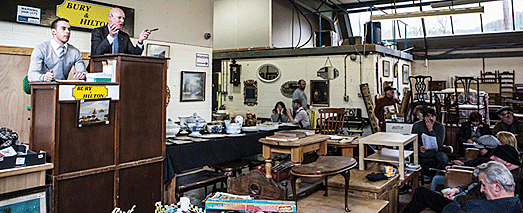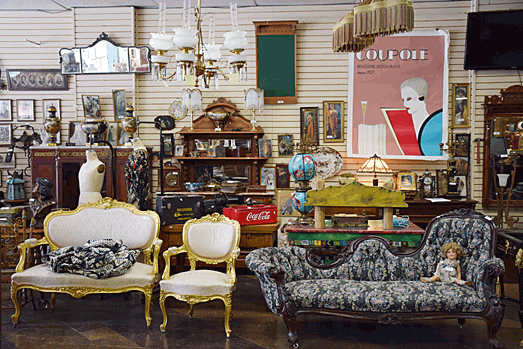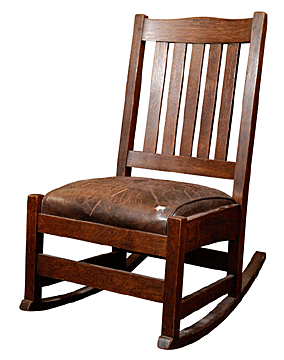|
Going, Going, Gone
by Bob Brooke
 And
we have a winner! And
we have a winner!
When I was in my late 20s
and early 30s, I used to go to country auctions. I did this more for
entertainment then to buy antiques. In fact, I hadnít begun collecting
them as yet, but I seemed to know beautiful pieces when I saw them.
One thing really bothered me about those auctions. It seemed that any
item I had an interest in was magically swept up by someone in the front
row. I never heard anyone voice a bid. Then before I knew it , the item
was gone and the auctioneer brought the hammer down.
I later found out that the people sitting in the front row were antiques
dealers who were regulars at this auction. They would bid by blinking an
eye or discretely lifting a finger or nodding their head. In most cases,
hardly anyone else in the room got to buy anything unless the regular
dealers didnít want it.
That, folks, turned me off to auctions until much later when I received
assignments to review them for antiques publications.
Changes in Antiques Auctions
 But
a lot has changed since then. Today, auctions are a bit more democratic,
mostly because other people are outbidding the dealers. In fact, the
tides have actually turned. At most live auctions today, everyone seems
to have a chance. Bidders need to register before the auction and
receive a numbered card on a stick which they can raise if they want to
bid. Whatever items they win get added to their account, which they can
settle up at the end of the auction. But
a lot has changed since then. Today, auctions are a bit more democratic,
mostly because other people are outbidding the dealers. In fact, the
tides have actually turned. At most live auctions today, everyone seems
to have a chance. Bidders need to register before the auction and
receive a numbered card on a stick which they can raise if they want to
bid. Whatever items they win get added to their account, which they can
settle up at the end of the auction.
In order to make a profit, antiques dealers have to buy items at a low
enough price to enable them to mark them up for resale, usually 100 to
200 percent. With everyone more or less equal in their bidding, dealers
often have to settle for items that no one else wants. While this is bad
for the dealers, itís good for you, the antiques collector.

In addition to changes in the way auction houses conduct their auctions,
the clientele attending them has also changed. Today, antiques auctions
are sophisticated affairs. While some dealers still attend and big on
items, many of the other patrons are people looking to furnish their new
suburban homes with what they think are quality items.
 Unfortunately,
many of these new bidders donít know much about antiques and are easily
fooled into bidding up items, especially pieces of furniture, that are
no more than reproductions or Indonesian knockoffs. They bid items up in
competition with other bidders instead of knowing when to stop, putting
the final bids of some things way over what the items are ultimately
worth. Unfortunately,
many of these new bidders donít know much about antiques and are easily
fooled into bidding up items, especially pieces of furniture, that are
no more than reproductions or Indonesian knockoffs. They bid items up in
competition with other bidders instead of knowing when to stop, putting
the final bids of some things way over what the items are ultimately
worth.
Another thing that has
changed about auctions is that, except for house and estate auctions and
the odd country affair, most live auctions tap into the Internet,
enabling people from anywhere to place bids. This increases the bidding
and drives up the prices, making more for both the auction house and
those that places items in the auction.
Buyers Who Behave Badly
In an era when it has become increasingly difficult for dealers to find
stock for their inventory, auctions are a place where temptations for
buyers to behave badly are perhaps accentuated by the palpable air of
competition that surrounds such events. These are just plain and simple
a violation of auction etiquette if not of ethics.
Some buyers, for example, mess with the box lots during preview. In this
sleight of hand, a buyer arranges his or her own box lot by
surreptitiously switching items between boxes previously arranged by the
auction house. In this way, the buyer amasses a lot he or she would like
to take home, enabling him to cherry pick at a box lot price. Naturally,
the buyer would have to do this late enough in the preview period that
someone can't come behind him and mess with the same lot. Dealers have
even been known to talk down merchandise in which they're particularly
interested so as to discourage other bidders and acquire a valuable
resale item cheap. It's sort of like hunting corralled deer where you're
the only hunter.

At the auction preview, it's a good idea to decide how much you'd be
willing to bid on any given item, then to stay strictly at or below that
level. Reining in your bidding horses in the heat of the adrenaline rush
is, apparently, easier said than done. More than once, a buyer has
confessed, when referring to a particularly high price he or she paid
for an item, that he or she paid way too much for the item at auction.
 Auctions
always involve a certain element of risk. But if you know Arts & Crafts
furniture by its reputation more than by your own expertise, you could
find yourself the top bidder in brisk competition for a Gustav Stickley
that turns out to be a Martha Stewart. Auctions
always involve a certain element of risk. But if you know Arts & Crafts
furniture by its reputation more than by your own expertise, you could
find yourself the top bidder in brisk competition for a Gustav Stickley
that turns out to be a Martha Stewart.
Even though you may resist the urge to spend beyond the limits you've
set for yourself prior to the auction, you should be realistic about the
maximum you'd be willing to pay. As a collector, you shouldnít pay more
than the item is actually worth. Even keeping an item for a decade or so
before selling it wonít bring you enough to cover your higher bid. Donít
give in to your competitive urge to beat out the other bidders. Leave
that sort of mentality for eBay.
<
Back to Antiques Extra! Archives
Next Editorial >
|
